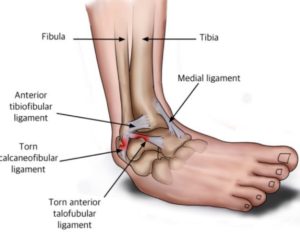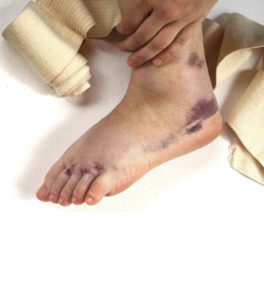Proprioceptive Training for the Prevention of Ankle Sprains: An Evidence-Based Review
- PMID: 29140127
- PMCID: PMC5737043
- DOI: 10.4085/1062-6050-52.11.16
Free PMC article
Abstract
Reference: Schiftan GS, Ross LA, Hahne AJ. The effectiveness of proprioceptive training in preventing ankle sprains in sporting populations: a systematic review and meta-analysis. J Sci Med Sport. 2015;18(3):238-244.
Clinical question: Does the use of proprioceptive training as a sole intervention decrease the incidence of initial or recurrent ankle sprains in the athletic population?
Data sources: The authors completed a comprehensive literature search of MEDLINE, CINAHL, SPORTDiscus, and Physiotherapy Evidence Database (PEDro) from inception to October 2013. The reference lists of all identified articles were manually screened to obtain additional studies. The following key words were used. Phase 1 population terms were sport*, athlet*, and a combination of the two. Phase 2 intervention terms were propriocept*, balance, neuromusc* adj5 train*, and combinations thereof. Phase 3 condition terms were ankle adj5 sprain*, sprain* adj5 ankle, and combinations thereof.
Study selection: Studies were included according to the following criteria: (1) the design was a moderate- to high-level randomized controlled trial (>4/10 on the PEDro scale), (2) the participants were physically active (regardless of previous ankle injury), (3) the intervention group received proprioceptive training only, compared with a control group that received no proprioceptive training, and (4) the rate of ankle sprains was reported as a main outcome. Search results were limited to the English language. No restrictions were placed on publication dates.
Data extraction: Two authors independently reviewed the studies for eligibility. The quality of the pertinent articles was assessed using the PEDro scale, and data were extracted to calculate the relative risk. Data extracted were number of participants, intervention, frequency, duration, follow-up period, and injury rate.
Main results: Of the initial 345 studies screened, 7 were included in this review for a total of 3726 participants. Three analyses were conducted for proprioceptive training used (1) to prevent ankle sprains regardless of history (n = 3654), (2) to prevent recurrent ankle sprains (n = 1542), or (3) as the primary preventive measure for those without a history of ankle sprain (n = 946). Regardless of a history of ankle sprain, participants had a reduction in ankle-sprain rates (relative risk [RR] = 0.65, 95% confidence interval [CI] = 0.55, 0.77; numbers needed to treat [NNT] = 17, 95% CI = 11, 33). For individuals with a history of ankle sprains, proprioceptive training demonstrated a reduction in repeat ankle sprains (RR = 0.64, 95% CI = 0.51, 0.81; NNT = 13, 95% CI = 7, 100). Proprioceptive training as a primary preventive measure demonstrated significant results (RR = 0.57, 95% CI = 0.34, 0.97; NNT = 33, 95% CI = 16, 1000).
Conclusions: Proprioceptive training programs were effective in reducing the incidence rates of ankle sprains in the athletic population, including those with and those without a history of ankle sprains.
Keywords: balance; coordination; reinjury.
What does this mean?
CORE Omaha Physical Therapy explains…
By Dr. Mark Rathjen PT DPT CSCS
This phrase “Proprioceptive training programs were effective in reducing the incidence rates of ankle sprains in the athletic population, including those with and those without a history of ankle sprains.” is the concise conclusion of the study.
Proprioceptive balance training is beneficial for many athletes and patients. Recurrent ankle sprains plague many types of athletes of all levels and all types. Specialized balance training will help and athlete move faster, react fast, put power to the ground faster and also prevent injuries. All of our protocols are driven by the athlete and their respective sport, and position in that sport.
It is also important to work reactive training drills, reactions drills, and vision occlusion drills to create body awareness and total athletic performance.
At CORE Physical Therapy and Sports performance, we specialize in athletes and have special training and experience in balance training.
CORE Physical Therapy in Omaha, This is who we are, this is what we do.
C.O.R.E. Physical Therapy and Sports Performance PC,
At CORE Physical Therapy in Omaha, We specialize in the treatment of athletes. We have worked with athletes for a combined 30 years.
This is who are, This is what we do.
Owned and Operated
by
Dr. Mark Rathjen and Dr. Claire Rathjen.
CORE is a family owned business that has been
established in 2015
We are proud to serve the greater Omaha metro area.
For More information, Please feel free to contact us https://coreomaha.com/contact/
Please feel free to follow us at https://www.facebook.com/COREomaha/
To get started https://coreomaha.com/getting-started/
For more Blog information https://coreomaha.com/blog/
CORE Physical Therapy and Sports Performance PC.
17660 Wright St, suites 9/10
Omaha, NE 68130
402-933-4027
Youtube Account linked below.
https://www.youtube.com/channel/UCVg8OSN5h-i1n_ykw1Gvahg?view_as=subscriber
Similar articles
-
J Sci Med Sport. 2015 May;18(3):238-44. doi: 10.1016/j.jsams.2014.04.005. Epub 2014 Apr 26.PMID: 24831756 Review.
-
BMC Musculoskelet Disord. 2008 May 20;9:71. doi: 10.1186/1471-2474-9-71.PMID: 18492235 Free PMC article. Clinical Trial.
-
Interventions for preventing ankle ligament injuries.
Cochrane Database Syst Rev. 2001;(3):CD000018. doi: 10.1002/14651858.CD000018.PMID: 11686947 Review. -
BMJ. 2009 Jul 9;339:b2684. doi: 10.1136/bmj.b2684.PMID: 19589822 Free PMC article. Clinical Trial.
-


